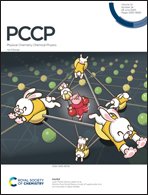Fibrous red phosphorene: a promising two-dimensional optoelectronic and photocatalytic material with a desirable band gap and high carrier mobility†
Abstract
By using density-functional theory, we have systematically investigated the structural stabilities, electronic structures, and optical properties of monolayer fibrous red phosphorene. We find the monolayer fibrous red phosphorene lattice to be dynamically and thermodynamically stable based on phonon spectra calculation and ab initio molecular dynamics simulation. A small cleavage energy of approximately 0.88 J m−2 is required for creating it from its bulk, suggesting the possibility of exfoliation in experiments. Furthermore, we find that monolayer fibrous red phosphorene is a semiconductor with an indirect bandgap of approximately 2.46 eV, and the bandgap is less susceptible to the number of stacked atomic layers. Moreover, the monolayer is expected to have highly directional anisotropy effective masses and high carrier mobilities (∼104 cm2 V−1 s−1), comparable with those of monolayer black phosphorene. In addition, fibrous red phosphorene nanosheets can absorb visible light as well as their band edge alignments are well positioned for the feasibility of both photo-oxidation and photo-reduction of water within the range of −5 to 5% biaxial strains. These combined properties make the fibrous red phosphorene nanosheets an alternative to diverse nanodevices, and pave the way for a potential photocatalyst.



 Please wait while we load your content...
Please wait while we load your content...